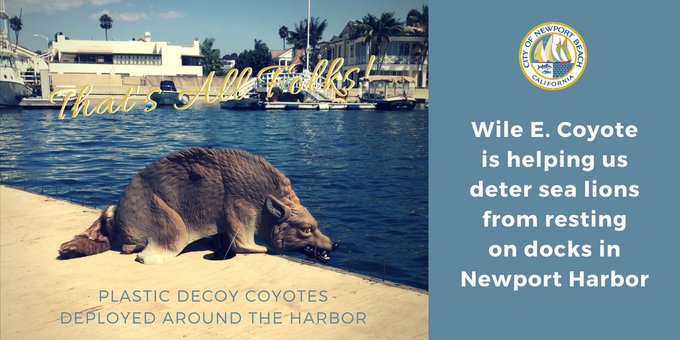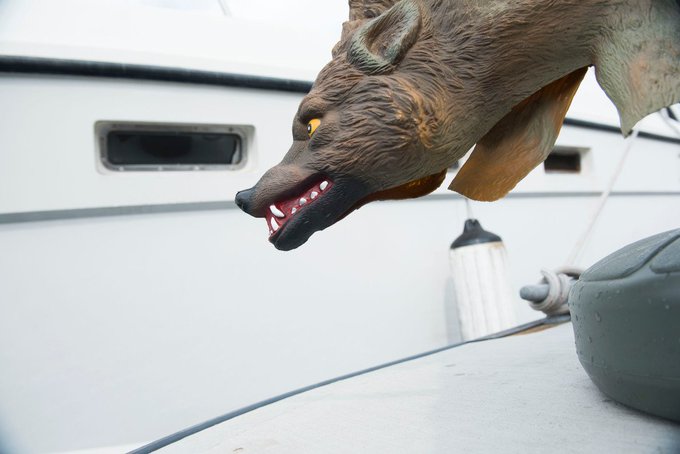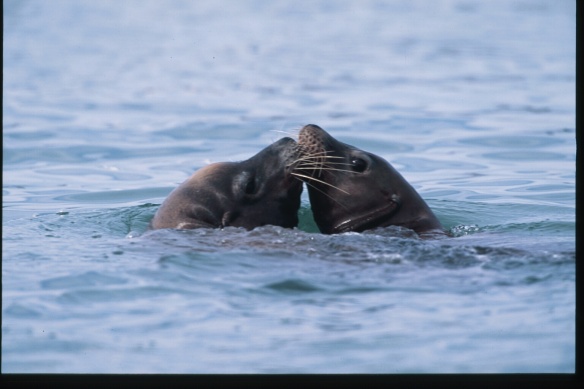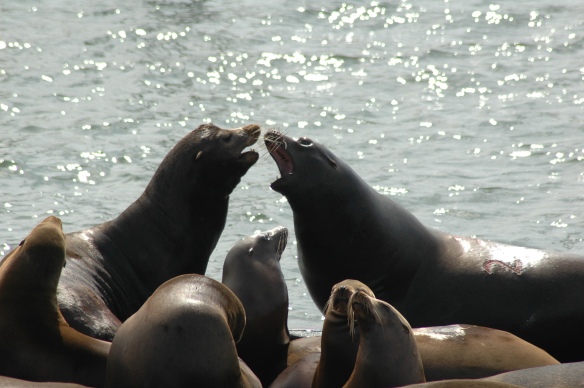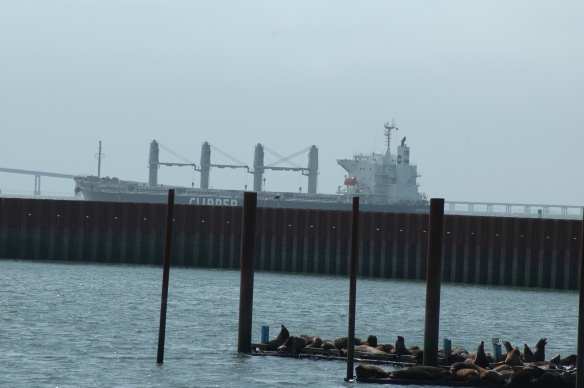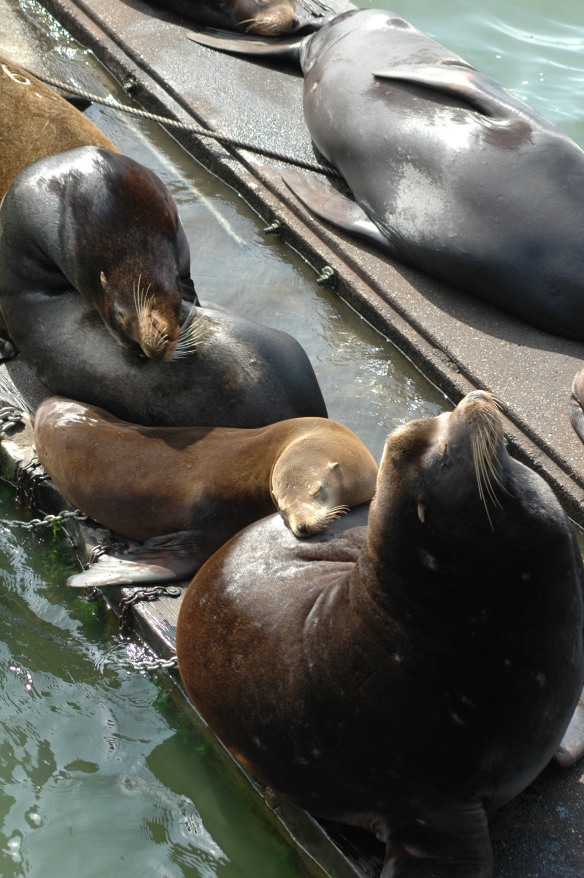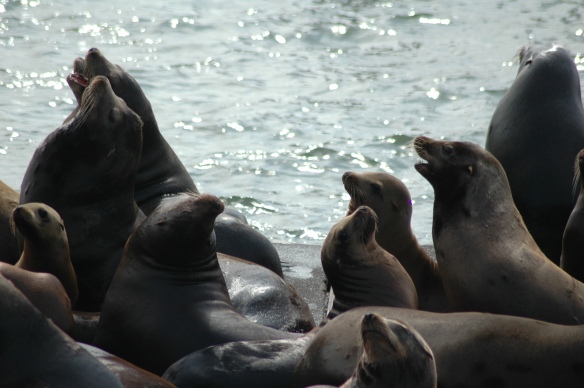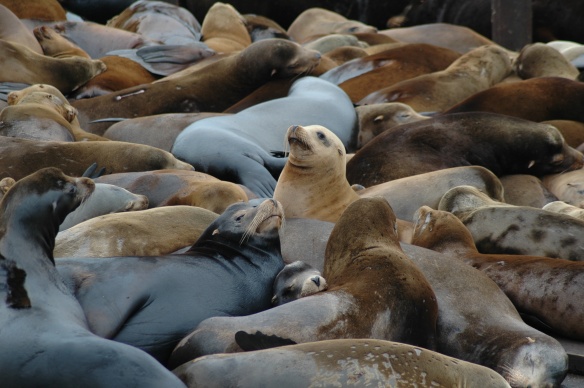Finding a reliable and cost-effective way to humanely repel sea lions isn’t easy. Never mind if the solutions are ridiculous looking, which they sometimes are. As long as it works and keeps working, that’s what matters.
Take for example, the ongoing sea lion-deterring efforts of Astoria, Oregon. In 2015, a desperate ploy to scare away an unruly colony of sea lions with a parade float-turned-boat painted like an orca literally went belly up in front of the impervious marine mammals. (They were obviously not amused by the high jinks.) A year later, officials enlisted a quartet of wacky waving inflatable arm-flailing tube men to frighten the pinnipeds away. Although only a temporary fix, it seemed to do the trick.
Dennis Durgan, the harbormaster of Newport Beach, California, opted not to go the Astoria route and instead look locally for inspiration. As city spokeswoman Mary Locey tells the Orange County Register, Durgan’s idea came straight from the Newport Harbor Yacht Club.
The brilliant, absurd and apparently effective solution?
Forty dollar plastic coyotes.
While unclear how often coyotes and sea lions actually encounter each other in the wild (uh, never?), the fearsome-looking decoys — available at a Walmart near you — proved successful at warding off sea lions at the yacht club. And so far, they’ve done a decent job on the public docks in Newport Beach’s scenic, semi-artificial harbor, too.
“We’re getting less complaints with the coyotes but we’re still getting plenty to make it a number one priority,” Newport Harbor dockmaster Ryan Sandford tells the Register. “This is probably the most affordable way to take care of this issue.
A meeting not common in nature
Newport Beach has long struggled with managing marauding sea lions that no doubt descend on the protected harbor because of its enviable real estate: spacious, well-maintained docks and hundreds of large yachts and expensive pleasure craft, all with glistening white bows perfect for basking under the bright Southern California sun. It’s all rather deluxe.
But when sea lions manage to waddle up swim stairs and make their way onto the boats, they can cause significant damage. If enough of the blubbery interlopers decide to congregate aboard a single boat, they can sink it. And while fun to look at and photograph, these highly intelligent beasts can be rowdy, surly and aggressive toward humans. They love being the life of the party, but when you ask them to leave, they trash the place and then chase you away.
 Don’t mind if we do: Sea lions lounge in sunny Newport Beach, California (Photo: Tracie Hall/flickr)
Don’t mind if we do: Sea lions lounge in sunny Newport Beach, California (Photo: Tracie Hall/flickr)
And so, the city is banking on a band of eight ersatz coyotes to help prevent further property damage. Normally, coyote decoys are used to spook Canadian geese (the clever and highly adaptable wild canines are a natural predator) as well as small animals like rabbits and skunks. The natural habitat of faux coyote tends to be golf courses, not upscale marinas. This particularly versatile model, with its comically giant yellow eyes and exposed fangs, is crouched in a ready-to-pounce stance. For added realism, it swivels and “wags furry tail with breeze.”
In order to better track the city’s newest unpaid employees, each coyote has been given a name. There’s Wile E., of course. As for the rest of them, the city decided to stick with the Loony Toons theme: Bugs, Taz, Elmer, Sylvester, Babs, Marvin and Yosemite round out the pack.
The Los Angeles Times notes that these unusual maritime scarecrows have been installed at “known sea lion magnets” around the harbor. One would hope that boat owners near these hotspots have been alerted to the presence of the somewhat startling decoys. Southern Californians may be used to interacting with normally shy coyotes, most are decidedly not used to encountering a creature that looks like the cartoon version of a rapid dog on a marina dock.
While Newport Beach officials are glad to lend assistance and protect property while maintaining public safety, individual boat owners are also required by the city to employ their own humane anti-sea lion techniques. It’s written right into the city’s municipal code. Popular approved methods include blocking swim stairs, installing snow fencing and setting out motion-activated sprinklers, which startle the resting animals and usually prompt them to hop back in the water.
It’s unclear how long the eight coyotes will be on the job even though the early results are positive. After a while, they’ll no doubt become less fearsome, more familiar. Their deterrent power will fade. “You have to constantly be creative with coming up with ideas,” Locey tells the Register. “The chances of them probably becoming used to these and realizing that they’re fake and not real is probably pretty high.”
If this does ever happen, it might be worth Newport Beach’s time looking into other decoys of predators that sea lions would never interact with in the wild. (After all, the Astoria killer whale ruse was a dud.) Perhaps a stern-looking owl might also prove successful.

